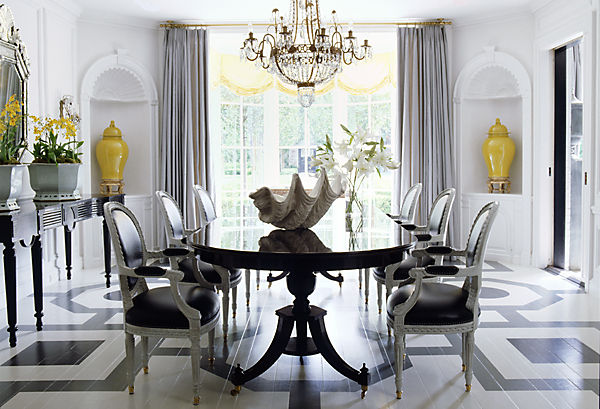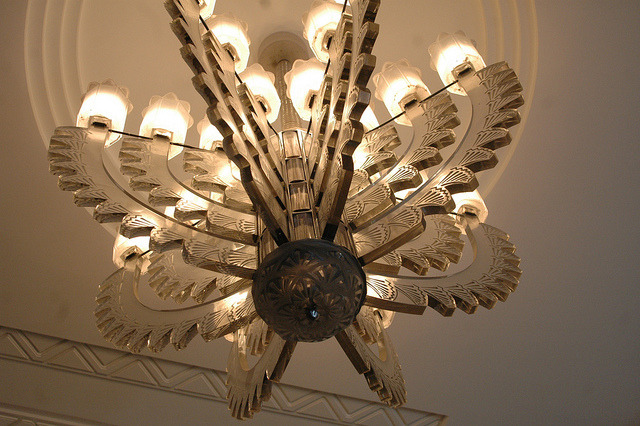 I am going to discuss Art Deco design in today's blog. Deco is the fascinating style we have recently seen in the visually stunning remake of the movie "The Great Gatsby". I have seen the movie twice, so far; once in 3-D and once not. I recommend the 3-D. Amazing!
I am going to discuss Art Deco design in today's blog. Deco is the fascinating style we have recently seen in the visually stunning remake of the movie "The Great Gatsby". I have seen the movie twice, so far; once in 3-D and once not. I recommend the 3-D. Amazing!
Art Deco was influenced by many countries, cultures, and
styles; including France, East India, China, Egypt, Native American, Africa, Greece, Aztec
Mexico, Harlem Renaissance, jazz, and
the then new –Industrialism. Elements of these styles evolved into deco along with the other influences.
The Bauhaus School brought the arts and crafts movement with cleaner lines and a more utilitarian function than the previous, more fussy designs of the Victorian era. Deco’s eclectic style was a result of the metamorphosis of Victorian design, the arts and crafts movement, and nouveau. The style grew into Hollywood Regency, cubism and modernism.
The Bauhaus School brought the arts and crafts movement with cleaner lines and a more utilitarian function than the previous, more fussy designs of the Victorian era. Deco’s eclectic style was a result of the metamorphosis of Victorian design, the arts and crafts movement, and nouveau. The style grew into Hollywood Regency, cubism and modernism.
Of the
above mentioned, France was the major contributor to Deco. While the design
style had been in vogue in Europe since the very early 1920’s, the name was
created for the 1925 World’s Fair- officially named
the Exposition Internationale des Arts Décoratifs et Industriels
Modernes, though the term “deco” was not commonly used until the 1960’s. In an effort to remain relevant as the
originator of style for the world, and to show that World War I had not affected the
excess of luxuries that were experienced before the war, the fair featured this glamorous
style.
Deco did not become common in the
U.S. until the late 1920’s, where a much more conservative approach was taken.
The city hall in Asheville, N.C is a wonderful example of one of the early deco
buildings in America.
The shapes and silhouettes of the opulent and elegant deco furnishings include angled and rounded geometric shapes integrated with the elongated and exaggerated lined derived from art nouveau.
Daisy and Tom's living room

Some characteristics of deco furnishings and trim include; relief elements that repeat and/or are stacked with stepped back facades, often of contrasting colors. These sometimes appear along with figural details, especially the erotic.
Various materials and motifs were used in deco furnishings, a few examples are; wood, early plastics such as celluloid and Bakelite- used to imitate natural materials, marble, ceramic, glass, lacquered finishes, mirrored veneer, metals-chrome, brass, and bronze; for high end pieces, porcelain, sterling silver, gold leaf, and precious gemstone were also used. It was quite common for any of these materials to be used for inlaid patterns on everything from furnishings, jewelry, and tchotchkes.The influence of pattern and images of exotic lands and cultures are evident in many of the inlays.



Gatsby's Ballroom
.

The textiles were of luxurious materials, usually with very detailed printed or woven patterns incorporating all the previously discussed design elements. The end result was always dramatic.



Designers of deco furnishings saw themselves as artists who contributed to all aspects of the composition- architecture, textiles, lighting, furnishings, wall covering, and so forth. I find this very interesting as this is the basis for twenty-first century interior design; we are no longer decorators, but frequently architects and contractors, we determine the switching plan for lighting, most custom design anything necessary, including furniture, fabrics, lighting, and flooring. We sometimes even design the landscaping.
Current deco design;Catherine Martin rugs


It is possible to find currently manufactured deco furnishings as well as vintage pieces online and in every antique shop. Many examples of furnishings that will work well in deco design are interspersed throughout current American manufacturers, and distributors lines.
 Global Furniture USA
Global Furniture USAHooker Furniture
Hooker Furniture
Shenzhen Matewell Arts & Crafts Co., Ltd. specializes in acrylic products.
Pollaro Custom Furniture, of New Jersey, specializes in high end furniture inspired by the great master furniture makers of the period.



Delta Co. produces a line of beautiful reproductions.
Interior designer Mary McDonald carries a strong nod to Art Deco into current day.




Art
deco lighting fixtures were no exception to the design elements discussed
prior. The fixtures were very detailed, and the “jewelry of the room”. The
coming of the widespread use of electricity had a tremendous impact on lighting
design. Electric light was used to illuminate frosted or stained glass panels. A
leader in the use of glass in lighting was the studios of Louis Tiffany.
Renee
Lalique was another prominent designer in glass and lighting design of the time.
Some
of the additional materials used in the period lighting were alabaster, chrome,
bronze, and brass.
The industrial age,
and the use of machinery was a great influence on the deco movement. The famed
artist, architect, designer, and writer Le Corbusier described the house as, “a
machine for living”. Deco was the first to embrace the mass produced.
An area of the U.S. where a
unique deco style developed from what the rest of the country was experiencing
at the time was Miami, Fl. In an effort to overcome the depression the city was
promoted by the developer as a tropical playground of the wealthy. The designs
were of tropical colors typical of the flora and fauna of the area, and the
architecture of the Caribbean islands. The motifs also used the coastal images
familiar to the residents and visitors- seashells, sea life, florals, palm
trees, tropical birds, and marine vessels. Many aspects of Hollywood regency
were later incorporated into the deco style of Miami.
The materials of choice for construction were stucco, concrete, metals,
etched glass, and other materials that could be molded or carved. Decorative
murals abounded on the sides of buildings and on interior walls.
As
we know, history repeats itself; deco has reappeared in updated versions
several times since its debut in the 1920’s. I am excited because we expect
to see a resurgence in its popularity with the release of the remake of "The Great Gatsby.
Leonardo DiCaprio
Robert Redford
Now, these photos really had nothing to do with Art Deco--- Your welcome!























